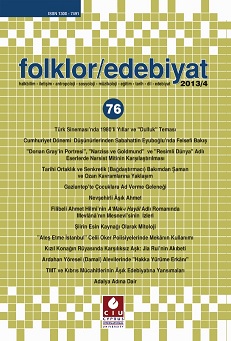Tarihî Genetik Ortaklik Ve Senkretik [=Bağdaştirmaci] Sanat Yaklaşimlari Bağlaminda Şaman Ve Epik Küyci [=Ozan]
Historical Genetic Partnership and Senkretik (Bağdaştırmacı) According to Art Approach Shamanist and Epic Kuyci (Minstrel)
Author(s): Eunkyung Oh, Mamatqul Jo’raevContributor(s): Bayram Durbilmez (Translator)
Subject(s): Cultural history, Customs / Folklore, Music, Poetry, Turkish Literature
Published by: Uluslararası Kıbrıs Üniversitesi
Keywords: Shamanist; Minstrel; Folk Singer; Epic; Religious Ceremony; Player;
Summary/Abstract: This essay is related with minstrel and shamanist. We have hypothesis concerning deep and tight relationship between shamanist and folk poet. Both of them are simultaneously musicians, singers, poet, yaratıcı and players. In old ages shamanist did all functions. When we analyze the notion of shamanist, we can understand that shamanist has deep meaning. According to the tradition, aşık who reads folk epic, sing a derleme or destan through dombria, kubiz and so on. One of the functions of destancılık okulu is (out of harezm destancılığı because in there aşıklar used intruments such as tar dutar and so on) singing epic works of Uzbek aşıkları through dombria. The qualifications of Epic türkücülük namely destancı aşık and shamanist aşıklarda musicians, türkücülük, poesy, extemporising (irticalen söyleme) and morover acting show us in advance, two characters of yorumculuğun (yorumculuğun genellikle psikolojik anlamı var bir şarkı söyleme yorumculuğu anlaımında ki kelimenin ingilizce karşılığını bulamadım) created as a all general traditional style. So, in advance shamanist attented rumuzlu and magical ceremony also they played an active role products of old folklore, mythological epic story yaratıcıları and he played an active role as a fist yorumcu. During the process ofthe historical evaluation of shamanist yorumcularının and folklore yorumculuk started to develop in a different way. Aşık who read epic works, during the porcess of development process his own yorumculuk, aşık created , read, and went thotugh some pases such as “Şaman/ sihirbaz aşık” ( synthetic historical type of aşıklık) “ türkücü aşıklık” (type of aşık who is yorumlayan and cereaed türküler related with herosim) and “destancı aşık” (clasical type of destancılık).
Journal: Folklor/Edebiyat
- Issue Year: 19/2013
- Issue No: 76
- Page Range: 63-76
- Page Count: 14
- Language: Turkish

